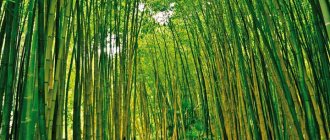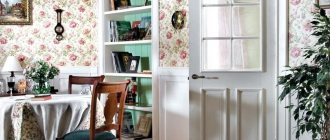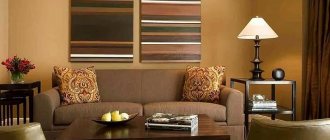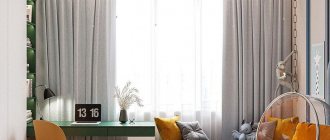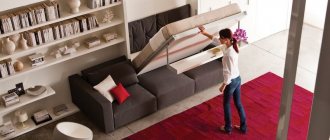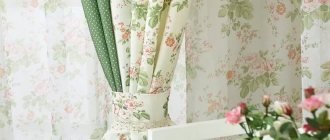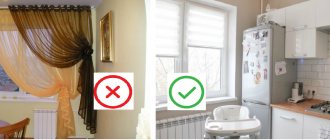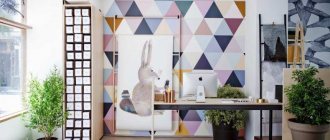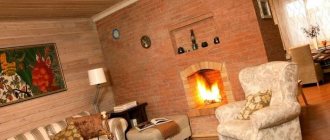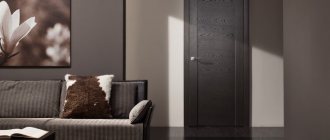Designers are constantly looking for fresh ideas that allow them to place color accents and create a special, homely, warm coziness. Until recently, living plants were most often used for these purposes. Today they have been replaced by artificial grass - it is used quite widely in the interior of a residential building. We'll tell you what you can do with it, how to decorate the space around you.
A bedroom that looks like a green lawn Source cozyblog.ru
Live grass in the interior instead of the usual flowers
Living grass is in no way inferior in appearance to conventional plants. Its thin spikelets will fit into any interior and will look good on the windowsill in the bedroom or on the dining table in the kitchen. A tall home lawn in narrow and long pots can zone the space, for example, separating the seating area from the kitchen. And live grass in small pots decorates the festive dinner table. Watch the video master class to learn how to grow live grass.
IMPORTANT: Grasses for home lawns belong to the grass family, and are divided into perennial and non-perennial. For home lawns, mixtures of these two types are usually used. Remember, perennial grasses grow slowly, for example, red fescue, meadow grass. But at the same time they delight with their appearance for several years. Non-perennial herbs grow quickly (about a month), but after two weeks they can dry out.
Live grass in a small pot
Long living grass in the interior of the kitchen dining room
Features of the new product
The advent of artificial grass, which outwardly quite skillfully imitates natural lawn cover, has changed a lot. A person who does not peer into its structure is unlikely to see a significant difference. Therefore, the illusion of deception is actively exploited by residential interior designers today.
A corner of green paradise in the house Source arxip.com
At its core, it is an ordinary synthetic fabric made from polymer fibers. They are machine woven into an elastic latex base. In this way, piles of different lengths and thicknesses are formed. Outwardly, it is very similar to the stems of green grass.
Artificial grass canvas Source greenveld.ru
Until recently, the material was actively used to create playgrounds, landscape decoration, and decorate swimming pools, terraces and roofs. Currently, designers are trying to use artificial turf in the interior of offices and residential premises. Many people liked its technical properties.
Artificial greenery in office interiors Source berkem.ru
Artificial lawn does not get trampled over time, and its bright emerald color does not fade. Green splashes help prevent the development of depression associated with the onset of long, cold winters.
Green color, psychologists say, prevents the development of depression Source behance.net
Artificial grass can be laid on any surface. The canvas allows water to pass through well and it never stagnate. For its production, environmentally friendly materials are used; the product does not emit hazardous substances into the air during operation. It easily tolerates heating up to +50̊ C and freezing down to -60̊ C. The structure does not deteriorate.
Flowers in a pot or live grass on the partition
In small apartments, finding a place for a tall flower in a large pot is not easy. An alternative is compositions of several small pots or tall living grass on zoning partitions. For example, you can also create such a partition with your own hands from a wardrobe hanger by hanging several flower pots on it.
TIP: Before buying plants, check whether the partition reaches the daylight the flowers need. If not, then choose plants that are not light-loving - Scindapsus (Epipremnum), Hamedorea, Ficus Benjamin, Dracaena, Cactus, etc.
Live grass on the partition in the interior
Climbing flowers on the partition in the bedroom interior
Climbing flowers on the partition in the living room interior
Climbing flowers on a homemade partition in the living room interior
Scope of use
It is not difficult to find a use for the material when decorating the interior. To do this, you just need to turn on your imagination and think about what you can make of it. Artificial grass is well suited for finishing balconies. It can completely cover the floor and hide its unsightly places. Sometimes canvases help avoid expensive repairs.
A lawn on the balcony helps avoid floor repairs Source pinimg.com
See also: Catalog of companies that specialize in the reconstruction of houses and the installation of winter gardens
The closed terrace will be significantly transformed if a green artificial canvas appears on the floor Source old.jutagrass.com.ua
Lay artificial turf in the children's room instead of carpets, then children, when playing and falling, will not get bumps on their elbows or knees.
The game room will be significantly transformed if artificial grass appears in it
Artificial grass inside a sports field Source architizer-prod.imgix.net
Soft, comfortable base for play Source theefaction.org
Pots of edible greens in the kitchen
For those who value practicality first and foremost, a green island can be created from edible greens. For example, form a flowerpot from a hoop, and attach parsley, mint, basil, etc. to them using clothespins. Video instructions at the link. Another option is to hang seed sprouters and grow your own greens in the kitchen. Attach greenery trays to a slate board and the board to the wall near the window.
Pots of edible greens in the kitchen
Pots of edible greens
Container for growing lawn at home
Indoor lawn can be grown either in a purchased or in a self-made container. So, you can easily buy a box or container of the size you need in a store, or you can take available materials and build a base for cultivating lawn grass on the windowsill with your own hands, especially since making a box with sides is not difficult.
Important! You cannot make a container for an indoor lawn from boards made from natural solid wood, as well as plywood and fiberboard. Such materials absorb moisture with which you will water your plants, which will cause rapid deterioration of the container.
Suitable materials include plastic sheets, polycarbonate, plexiglass, etc. Simply cut out the required dimensions and connect them with screws, bolts, self-tapping screws or other fasteners using a drill.
Two boxes need to be made: one for direct growing of grass, and the other should be much larger and serve as a tray for the accumulated moisture that will be released after watering.
Home greenhouse on a stepladder
If the window sills are small, the coffee tables are occupied, or you just want something new, then create a mini-greenhouse right on a stepladder or old staircase. Pre-paint the stepladder in the desired color. You can also store books and any other decor on it besides flowers or pots of live grass.
TIP: Scandinavian, modern and minimalist interiors will suit any variation of pots - from metal and mirrored to old wine bottles. And pots made of dark clay and ceramics will fit into classic interiors.
Suitable here: https://dg-home.ru/catalog/vazy/
Home greenhouse on a stepladder
Home greenhouse on a stepladder
Home greenhouse on a stepladder
Substrate preparation
The soil for lawn grass should be loose and porous with a neutral acidity level. The substrate can be purchased at a specialized store, or you can prepare it yourself. To do this you will need sand, silt and clay in proportions of 2:2:1. At the bottom of the box it is necessary to lay out a layer of drainage made of expanded clay, balls, pebbles or other materials. The drainage components should be doused with boiling water for disinfection purposes, and the substrate itself should be calcined.
Homemade vines in flowerpots
In country houses or loft interiors, where the beams are exposed, you can hang home vines directly on them. If there are no beams, you can hang flower pots on ceiling hooks. And if you don’t want to spoil the ceiling, then use special wooden platforms on the walls.
TIP: In rooms with low ceilings, hang the planter in a corner. This way it won't interfere.
Homemade vines in flowerpots example
Homemade vines in flowerpots
Homemade vines in flowerpots
Homemade vines in flower pots, example
What is artificial grass
Plastic grass is an imitation of natural lawn covering, made of polyethylene and a rubber base. The production of such flooring is widespread throughout Russia; the greatest demand is for inexpensive products from. Lawn flooring can be seen on outdoor golf courses, near swimming pools and in areas reserved for sports games. Some types of carpet have drainage systems to drain water, so that during watering, residual moisture will not accumulate on the surface.
Lawn covering
To ensure the maximum level of comfort during various sports, artificial grass is used. This invention has greatly simplified the maintenance process of modern football fields and tennis courts, allowing players to fully concentrate on the game. At low temperatures, the service life of a plastic lawn will reach fifteen years, but such wear resistance is extremely rare. Monofilament products are not very durable, which necessitates replacement every 5-7 years.
Coating Grass in rolls
Unlike backfill, the quality of which in most cases leaves much to be desired, applications with high pile density are much more often used in construction and landscaping. Artificial grass in rolls has several important advantages, which allows the covering to be used both indoors and outdoors. Buying plastic lawns at a low price will soon disappoint you with the lack of proper strength properties in conditions of elevated temperatures. Therefore, it is recommended to purchase only high-quality products from trusted stores.
Carpet Artificial grass
The sale of plastic flooring is carried out not only for country estates and street terraces; delivery to private homes or sports complexes is no less successful. The use of lawns as a decorative element of rooms is widespread in interior design. With the help of plants and figures of different shapes, even a complex project can be realized, and green carpeting is the logical conclusion of the work done. Products are produced that are adapted for office space, since natural elements have a beneficial effect on human well-being.
Grass for decoration
In the process of garden design, you often come across complex areas that require the use of universal, unpretentious materials. In such cases, plastic coating is an indispensable attribute of landscape work, since further implementation of the project without the use of alternative devices is impossible. In areas that are difficult to reach for cultivation, lawn grass is laid out or polyethylene plants are planted. High-quality products feel much softer to the touch than cheap analogues, but the cost of such coating is also more expensive.
How to lay it correctly?
The main rule for laying a lawn with your own hands is to carefully prepare the soil, and all work must be done in dry weather. Soil preparation is not only about leveling and removing weeds. If the soil on the site is quite clayey, with poor moisture permeability, then you should take care of installing a drainage system. To do this, a special membrane is laid on the ground to allow moisture to pass through. It is sprinkled with crushed stone on top, on which a base is laid, and a lawn covering is laid on it in turn. In some cases, you can limit yourself to digging a trench around the perimeter of the site, which is filled with crushed stone and covered with earth.
In regions where there is a fairly large amount of sand in the soil, it is impossible to do without using a special metal grid that prevents the appearance of holes under the influence of heavy loads on the soil. If the area where the artificial grass flooring will be laid is concrete, then you can immediately begin laying the strips. If the plantation is ground, then before attaching it to the ground, it is necessary to level the surface, removing all weeds.
Experts recommend treating the soil with a special weed-preventing solution before laying the lawn. The strips of rolled lawn are spread in length and overlap, which will prevent them from being pulled aside during use. For installation, make sure you have the following tools.
- A knife with a sharp and strong blade.
- Spatula, the height of the teeth should be at least 3 mm.
- Shovel, rake and hard broom.
- Vibratory shovel or hand roller for compaction.
- Hammer and pins for non-concrete bases and dowels, hammer drill for concrete.
- Rubber brush for removing glue residue and tape measure.
- Joining tape coated with glue to secure the strips.
- Lawn lattice for forming paths. Its use is determined by the condition of the soil itself: it is not needed on a concrete base. If the base is soil, then you should take care of purchasing it.
Once the soil is ready, we lay lawn sheets cut to the required size on it. This must be done by overlapping one strip over the other by about 1.5 cm. The layers must be cut evenly, otherwise this will cause wrinkles to appear. For the same reason, you should not rush to fix the coating, and after installation, leave it for 12 hours so that it can straighten out.
Afterwards we proceed to fixation, which we do using glue or staples. We cover the joints of the strips with connecting tapes, the width of which varies from 25 to 30 cm. The tape is also attached with glue, after which it is necessary to go over it with a hand roller for better fixation.
It is advisable to secure the lawn around the perimeter with a special border, otherwise it may move to the side due to loads. The border is also fixed with glue. The work started on laying the lawn should not be put on hold, otherwise, due to possible temperature changes, the fixation of the glue will be uneven, which will also cause swelling or even periodic peeling.
The final touch is filling the lawn with sand or a special granulator (if the lawn is infill or semi-infill). The exact size of the fraction is indicated in the instructions for the selected lawn. After all the work done, you need to comb the lawn with a rake, removing any remaining glue and sand.
Required accessories
There are a number of basic tools that will help you lay a lawn yourself.
These include:
- Cutter. With this tool you can cut the lawn leaf along the line you need.
- An edge trimmer helps cut strips of faux fabric.
- A special metal grip for leveling the coating on the site.
- A special metal cutter for trimming the edges of artificial products.
- Lawn fixer for joining layers before gluing them.
- A two-component polymer-based adhesive that adheres artificial grass to a previously prepared surface.
- A shock-absorbing substrate is necessary as an immediate base for attaching the lawn.
- The seam lock is used to raise the pile and ensure a strong connection of the rolls at the joints.
- To apply glue to the mounting tape, you should use a special mechanical tool for applying the adhesive substance.
- The brush is used for final cleaning of the surface from soil or building materials.
How to lay it?
The technology for installing a roll of artificial grass is not as simple as it might seem at first glance.
In order for it to last a long time, the installation must be correct, especially if you decide to lay the canvas yourself. The main thing is to thoroughly prepare the surface on which the material will be attached. Before you start work, you need to accurately calculate the area and decide on the shape, and then transfer the results to the roll. In this way, a minimum number of seams and waste is achieved.
Preparing the basis
The foundation has several basic requirements:
- No trash.
- Smooth surface.
- If this is soil, then it must be dense; we eliminate looseness.
Thus, we begin the work by completely cleaning the area. We remove weeds and other unnecessary vegetation mechanically or chemically
It is important to remove all debris that could damage the integrity of the coating. If the base is earthen, then at the same time we level the surface, fill potholes, fill the holes with soil
After all these manipulations, we compact the earth.
It is advisable to check the horizontalness of the base using a laser level. Optimal value: from 3 to 6 mm of slope per 1 linear meter
This value is especially important when laying the roll on concrete. If there is sand on the territory, it must be removed
Then compact the opened layer and place a drainage layer on it.
Removal of excess moisture
To protect the surface of the lawn from the accumulation of liquid, for example, during rain or snow, it is necessary to ensure its outflow. Liquid can drain and linger directly under the canvas. To avoid such an outcome, arrange drainage at a sufficient depth.
A lawn base made of fine and medium gravel copes well with this task. Before laying a roll of grass, you should fill this area with water to identify areas of soil subsidence. If any are found, then soil should be added to this place.
Substrate
Each base has its own substrate, consisting of a different number of layers.
Concrete base:
- Artificial turf.
- Geosynthetic material.
- Reinforced concrete.
- Crushed stone 20 and 40 mm.
- Geotextiles.
- Sand.
- Geotextiles.
- Pre-compacted soil layer.
Base made of crushed stone and sand:
- Artificial turf.
- Granite screening 1 and 5 mm.
- Crushed stone 5 and 20 mm.
- Geotextiles.
- Sand.
- Geotextiles.
- Pre-compacted soil layer.
Crushed stone base:
- Synthetic lawn.
- Rubber shock-absorbing backing.
- Fine granite screenings.
- Large crushed stone.
- Geotextiles.
- Pre-compacted soil layer.
These examples are given for professional decorative work or design of sports grounds. The number of layers may be reduced if the load on the lawn is light.
Installation of artificial grass
- Take the roll and unwind it in one direction. So that the villi are literally tilted to one side.
- We lay the fabric exactly butt-to-butt, but if the edges are crooked, then we overlap up to 10 cm.
- Let the material sit for one day so that it is completely straightened and minor defects in the grass disappear.
- It is necessary to cut the roll in the middle of the overlap with a stationery knife or scissors using a ruler and chalk.
- By pulling the edges of the two canvases, we check how tightly they fit together. The gap between them should not be more than 1 mm.
- After this, we connect the edges of the lawn cloths with a tension stitcher or connecting tape. The instructions must indicate the connection method.
Useful tips to make your work easier:
- It is better to apply two-component glue to the connecting tape using a notched spatula (3-5 mm). In this case, excess glue will not protrude on the canvas.
- During work, do not allow dust to settle on the belt, leaves and waste (clippings) to stick.
- You need to place a heavy object on the freshly joined edges to help them grip better.
- It is better to distribute sand and granules with a rake, broom or seeder.
